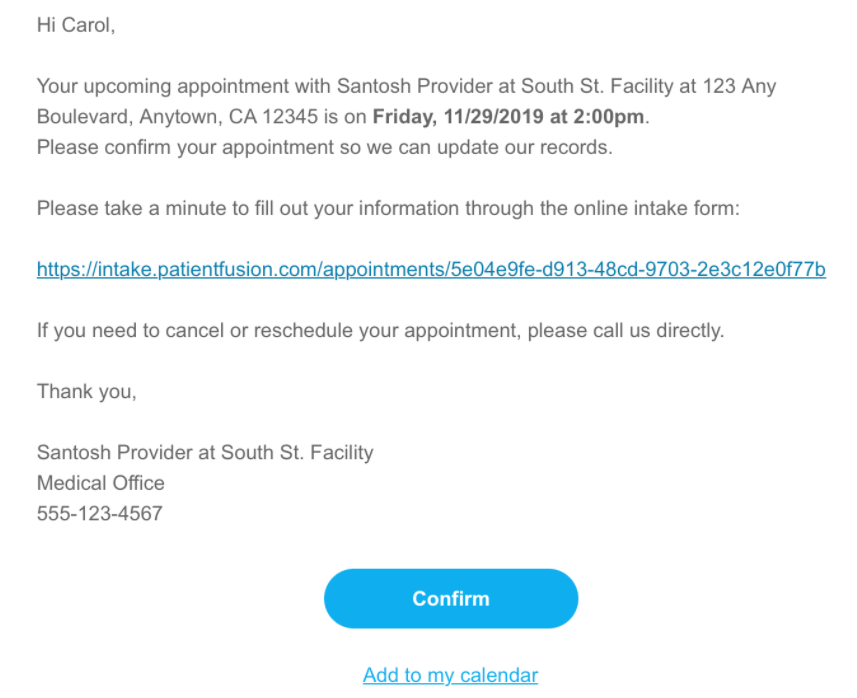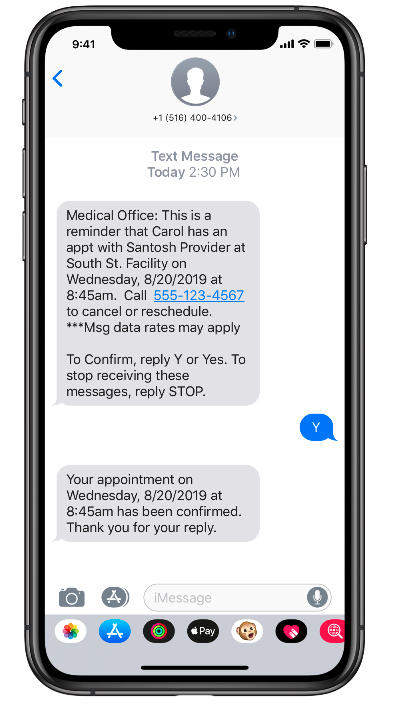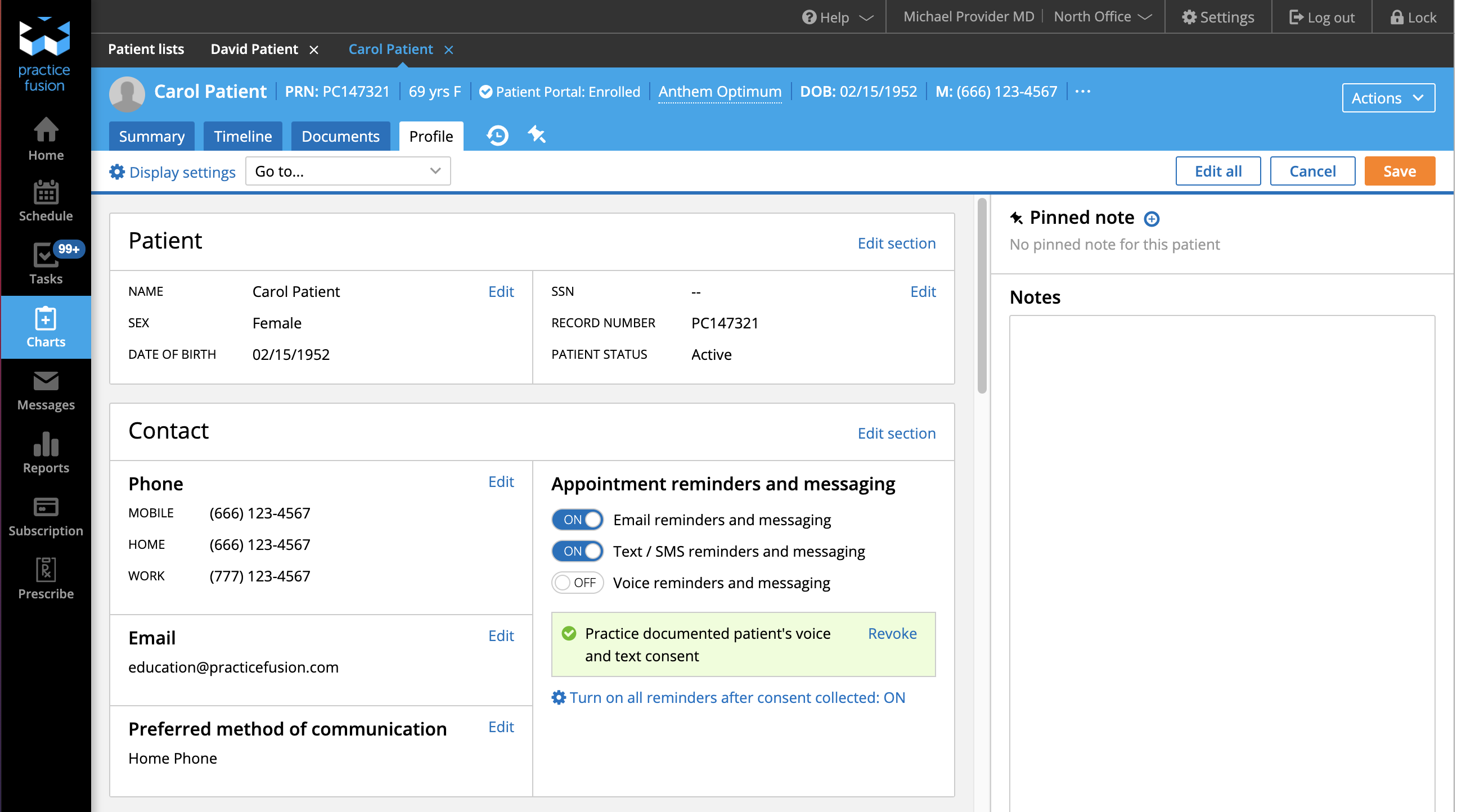June 15, 2021
How to Reduce Patient No-Shows with Automated Appointment Reminders

Patient no-shows are a common problem, one faced by medical practices of all types and sizes. A study published before the COVID-19 pandemic in The American Journal of Medicine found that without some type of reminder, patients did not show up for their scheduled appointments 23.1% of the time.1
The increased use of telehealth during the pandemic has improved the no-show problem somewhat but has not eliminated it. In one study, the no-show rate for telehealth visits was 7.5%, compared with a no-show rate of 36.1% for scheduled in-office visits during the same time period. It was also lower than the pre-COVID-19 in-office no-show rate (29.8%).2 The Taskforce on Telehealth Policy reported that early evidence suggests that increasing the use of telemedicine has served to reduce rates of patient no-shows.3 That said, patient no-shows are still an issue healthcare providers face every day.
In this article, we discuss the impact that patient no-shows can have on both patient outcomes and practice efficiencies. We share how the widespread use of mobile devices has contributed to an impactful change in how physician practices deliver appointment reminders and describe the benefits of automated appointment reminders. Finally, we explain how, at no additional cost, you can start using automated appointment reminders in your Practice Fusion EHR.
Impact of patient no-shows
When a patient fails to come to their appointment it can have a negative effect on patient outcomes. Not only does the patient fail to receive needed medical care; missed appointments have also been shown to decrease compliance with the patient’s plan of care, which can lead to more costly downstream care needs.4 This outcome is antithetical to the goal of value-based care models which emphasize the quality of care and cost reduction.
Patient no-shows can also contribute to lost clinician time, decreased practice efficiency, and the inability for healthcare providers to see other patients.1,5,6 In an effort to deter patients from not showing up for their appointments, some providers charge patients a fee for missing appointments without advanced notice. Beginning in 2007, the Centers for Medicare & Medicaid Services (CMS) provided guidance allowing providers to bill Medicare beneficiaries for missed appointments, as long as the practice followed certain guidelines. However, this fee only covers the cost of a missed business opportunity. It does not replace the lost revenue from the missed appointment, or take into account the negative impact missed appointments can have on value-based care reimbursements.7,8
Research has shown that practices can overcome many of these problems by using appointment reminders. However, manually delivering appointment reminders and rescheduling can monopolize hours of staff time.9,10 Many practices have used postcards or letters for appointment reminders, but today many are moving to email, phone calls, and short message service (SMS) text messaging to remind patients of their appointments.
Widespread use of mobile devices
The widespread use of mobile devices has opened the door for physicians to begin delivering automated appointment reminders via SMS. In the past few years, the number of smartphone users increased by 40% worldwide. In 2021, there are 3.8 billion smartphone users in the world, or 48.33% of the world’s population. Smartphone usage in the United States is even more pervasive at 79.1% of the population,11,12 and the average U.S. adult spends about three hours and forty-three minutes a day on their mobile devices.
Spending so much time on their phones means people tend to respond to SMS text messages more rapidly than to other forms of communication.13 This means:14
- About 98% of SMS text messages are read (vs. 20% for email messages)
- About 90% of SMS text messages are read within three minutes
- SMS text messages have a response rate of 45% (vs. a response rate of 6% for email messages)
Benefits of automated appointment reminders
A review of the research on using SMS text messages in healthcare services found that SMS appointment reminders have been used successfully in a wide variety of settings, including primary care, dental care, and psychotherapy clinics. Appointment reminders were found to:12
- Increase the rate of appointment attendance
- Decrease the rate of missed appointments
- Increase the rate of appointments cancelled ahead of time (rather than patient no-shows)
These results enabled healthcare providers to save time and money and maintain uninterrupted care for their patients.12
In another recent study, the Medical Group Management Association surveyed healthcare providers about their use of automated appointment reminders. Practices using automated reminders reported:15
- Higher revenue
- Lower patient no-show rates
- Better overall appointment utilization
- Fewer unfulfilled appointments
- Ability to see more patients
- More time for staff
If you use Practice Fusion’s electronic health record (EHR) system, appointment reminders are included in your subscription. Read on to learn more about appointment reminders, including how to set up and use these reminders in your practice.
Getting started with appointment reminders: Enable messaging options and obtain patient consent
Appointment reminders are included in your Practice Fusion EHR subscription. You can use Practice Fusion’s appointment reminder feature to send patients reminders via email, SMS text messaging, or voice telephone calls.16,17 Appointment reminders are HIPAA compliant and integrate completely with your Practice Fusion EHR.18
Before you can start using reminders, though, you must do several things: enable appointment reminders in your EHR settings, document patient consent for messaging, then turn on specific types of appointment reminders in the individual patient profiles. For a step-by-step walkthrough showing how to enable messaging in both the EHR and patient profiles, click here.
Practice Fusion’s automated appointment reminders
With Practice Fusion’s automated appointment reminders, you can configure the reminder settings once and then never touch them again. For example, if you update your practice information, future appointment reminders will automatically contain updated contact details. Appointment reminders are also integrated with your Practice Fusion EHR, so that patient confirmations automatically sync with your practice calendar. Practice Fusion’s time zone settings will affect appointment reminders, but time zone settings on individual computers will not.6
Use appointment reminders to deliver reminder messages in seconds and avoid phone tag—freeing up more time for your patients. Practice Fusion’s appointment reminders offer three different options for delivery methods: email, SMS text messaging, or voice calls.16,17 Patients may receive up to three reminders per appointment, depending on which communications preference(s) have been selected.16,19
Patients can confirm their appointments via all three appointment reminder types. From an email message, the patient clicks “Confirm.” From an SMS text message, they reply “Y” or “Yes.” From a voice call, they press “1.” When they confirm an appointment, that appointment will be automatically updated in the EHR scheduler. If a patient needs to cancel or reschedule an appointment, they will need to contact the practice directly.16


Patients can also unsubscribe from all three appointment reminder types. They do so by clicking “Unsubscribe” from an email message; replying “STOP” to an SMS text message; or pressing “5” on a voice call. Providers can also enable or disable any type of appointment reminder in the patient profile using toggles to turn them on or off.16

If your administrator has enabled patient intake with the appointment reminder process, email appointment reminders will also contain a link to allow patients to complete Online Check-In.16 Online Check-In enables patients to fill out forms prior to their appointment, at their convenience. This increases staff productivity as well. (Note: At this time, patient intake forms are only available via email appointment reminders.)18
Add additional appointment reminder features a la carte
Additional customization features can be added to your Practice Fusion subscription a la carte. The option for customizable appointment reminders enables you to modify the frequency of your appointment reminders. You can use this feature to customize messages to patients to add a personal touch for your practice.
You can also add information relating to specific appointment types, such as fasting instructions or instructions to bring medications to an appointment. Practice Fusion offers a library of appointment reminder templates you can use for common appointment scenarios. Alternatively, you can create your own templates for common visit types.6,18
Automated appointment reminders can reduce patient no-shows and save your practice both time and money. Check out our knowledge base to learn more about using automated appointment reminders in your practice.
References:
- Parikh A, MD, MBA, MS, Gupta K, MD, MBA, Wilson AC, PhD, Fields K, CPC, Cosgrove NM, RN, Kostis JB, MD. The Effectiveness of Outpatient Appointment Reminder Systems in Reducing No-Show Rates. The American Journal of Medicine. 2010 123:542-548.
- Drerup B, Espenschied J, Wiedemer J, Hamilton L. Reduced No-Show Rates and Sustained Patient Satisfaction of Telehealth During the COVID-19 Pandemic. Telemedicine and e-Health. 00(00):1-7. doi:10.1089/tmj.2021.0002
- Taskforce on Telehealth Policy. Taskforce on Telehealth Policy (TTP) Findings and Recommendations Executive Summary, Latest Evidence: September 2020. September, 2020. https://www.ncqa.org/programs/data-and-information-technology/telehealth/taskforce-on-telehealth-policy/executive-summary/
- Taskforce on Telehealth Policy (TTP). Taskforce on Telehealth Policy (TTP) Findings and Recommendations: Telehealth Effect on Total Cost of Care. September, 2020. https://www.ncqa.org/programs/data-and-information-technology/telehealth/taskforce-on-telehealth-policy/taskforce-on-telehealth-policy-findings-and-recommendations-telehealth-effect-on-total-cost-of-care/
- Greenhalgh T. New Appointment Algorithm Helps Clinicians Manage Time Better. Rheumatology Advisor. Updated January 10, 2019. Accessed May 13, 2021, https://www.rheumatologyadvisor.com/home/topics/practice-management/new-appointment-algorithm-helps-clinicians-manage-time-better/.
- Patient Reminders. updox. Accessed May 13, 2021, https://www.updox.com/solutions/patient-experience/patient-reminders/.
- Keohane P, JD, MPH, CPC. How to Bill for Missed Appointments: Know the Rules For No-Shows. AAPC. Updated November 1, 2007. Accessed May 27, 2021, https://www.aapc.com/blog/23888-how-to-bill-for-missed-appointments/#:~:text=In%20most%20instances%2C%20hospitals%20are,all%20patients%20are%20charged%20equally.
- MLN Matters MM5613 Revised: Charges for Missed Appointments (CMS) 1-3 (Updated November 12, 2014).
- Measuring the Cost of Patient No-Shows. CareCloud. Accessed May 13, 2021, https://www.carecloud.com/continuum/measuring-cost-of-patient-no-shows/.
- Survey Confirms Automated Phone Messages as Optimal Appointment Reminder Method. West Corporation. Accessed May 13, 2021.
- Turner A. How Many Smartphones Are in the World? bankmycell. Updated May, 2021. Accessed May 13, 2021, https://www.bankmycell.com/blog/how-many-phones-are-in-the-world#:~:text=In%202021%2C%20the%20number%20of,62.07%25%20of%20the%20world’s%20population.
- Schwebel FJ, Larimer ME. Using text message reminders in healthcare services: A narrative literature review. Internet Interventions. 2018;13:82-104. doi:10.1016/j.invent.2018.06.002
- Zalani R. Screen Time Statistics 2021: Your Smartphone Is Hurting You. Elite Content Marketer. Updated February 25, 2021. Accessed May 13, 2021, https://elitecontentmarketer.com/screen-time-statistics/#:~:text=A%20study%20of%2011k%20RescueTime,minutes%20on%20their%20mobile%20devices.
- Magaline V. 60 SMS Marketing Statistics That Will Change Your Mind About Text Message Marketing. Mobile Monkey. Accessed May 13, 2021, https://mobilemonkey.com/blog/sms-marketing-statistics.
- Fabrizio N, PhD, FACMPE, FACHE. Automated appointment reminders lead to fewer no-shows. Medical Group Management Association (MGMA). Updated February 28, 2019. Accessed May 13, 2021, https://www.mgma.com/data/data-stories/automated-appointment-reminders-lead-to-fewer-no-s.
- What is the appointment reminder process for Practice Fusion Essentials? Practice Fusion. Accessed May 14, 2021, https://help.practicefusion.com/s/article/What-is-the-appointment-reminder-process.
- How do I enable SMS text and voice messaging for the Practice Fusion Essentials appointment reminders? Practice Fusion. Accessed May 14, 2021, https://help.practicefusion.com/s/article/How-do-I-enable-text-and-voice-messaging-for-the-Practice-Fusion-Essentials-appointment-reminders.
- Appointment Reminders and Patient Engagement Solutions. Practice Fusion. Accessed May 14, 2021, https://practicefusion.com/appointment-reminders-patient-engagement-solutions/.
- Updox With Practice Fusion. Updox. Accessed May 14, 2021, https://info.updox.com/pf-premium.
